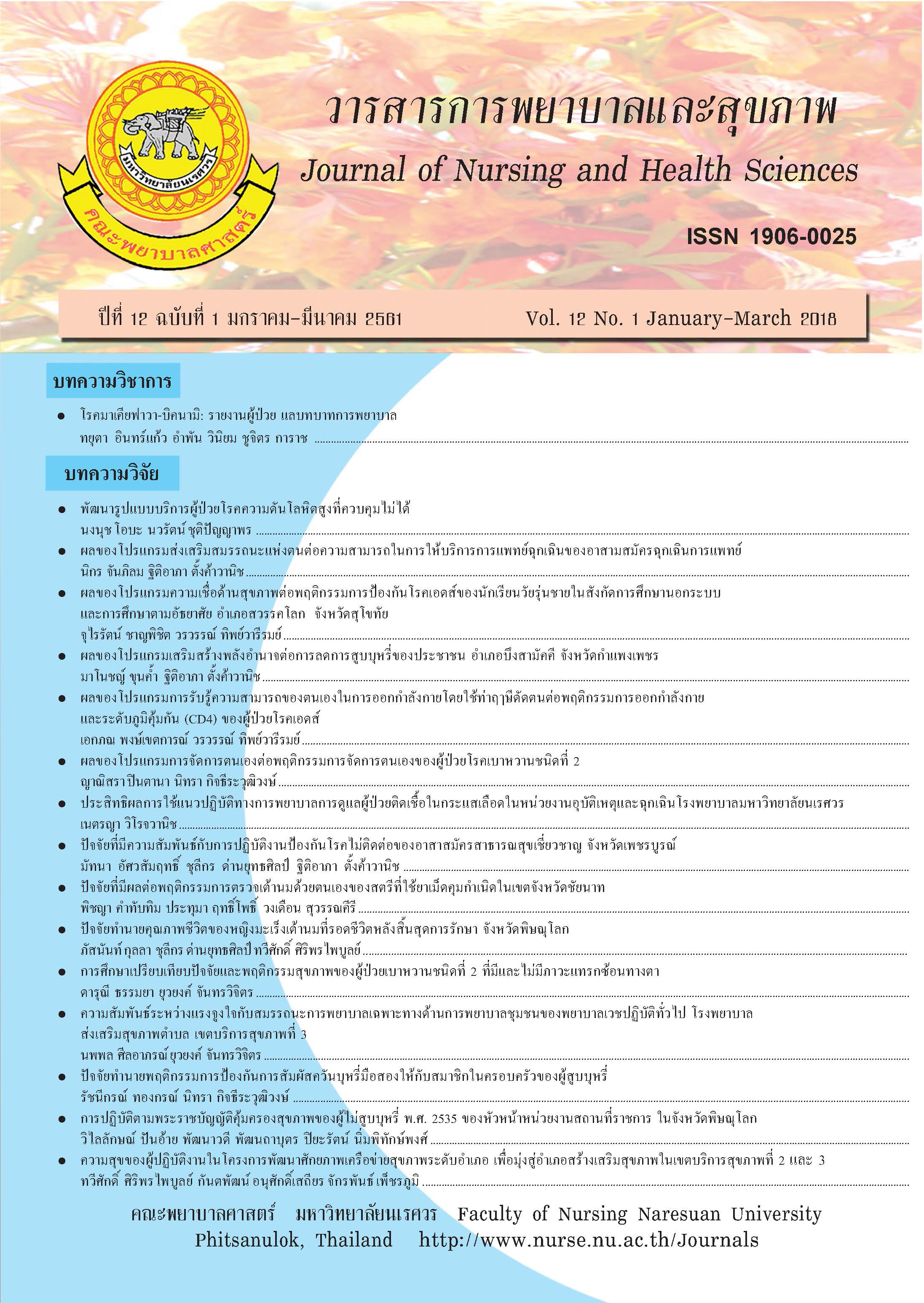Factor Predicting of Smoker’s Behavior Towards Protecting Family Member from Exposure Second Hand Smoke
Main Article Content
Abstract
This predictive correlation research aimed to assess the level of preventive behaviors of smoker towards protecting family member from exposure Second hand smoke and to indentify factors predicting of smoker’s Second hand smoke exposure at home in Bangrakao district, Phitsanulok Province. Sample size determination was apply by estimating a population mean, obtained 270 active smokers with multi-stage sampling. 211 questionnaires were return with a response rate of 78.15%. The instrument used was a 58-item questionnaire which was developed by applying the PRECEDE model. Data were analyzed by using descriptive statistics and stepwise multiple regression analysis. The results shows that the majority of samples were male (72.7%), completed primary school (56.9%) and have been practicing smoker’s preventive behaviors for Second hand smoke exposure of smokers at a high rate (Mean = 25.52, S.D. = 6.03). In addition, stepwise multiple regression analysis indicates that enabling factors (environment, family commitment and tobacco accessibility) (B = 0.69), perceived severity of disease occurred from second hand smoking (B = 0.45) and reinforcing factors (supporting from family, peer and healthcare personnel) (B = 0.21) accounted for 38% of preventive behaviors for Second hand smoke exposure of smokers with the significance level of p-value < 0.05. The recommendations from this study are to inform healthcare personnel in enhancing healthy environment in relation to protecting of family member from Second hand smoke such as smoke-free home interventions, establishing family commitment, controlling access to tobacco product, increase perceived severity of disease occurred from second hand smoking and reinforcement by family, peers and healthcare personnel. Theses activities will lead to improve preventive behaviors for Second hand smoke exposure of smokers.
Article Details
References
WATCH จับตาโรคและภัยสุขภาพ. สืบค้นจาก
http://www.boe.moph.go.th/files/news/
20140729_18495804.pdf
นิภาวรรณ หมีทอง. (2551). ปัจจัยเชิงสาเหตุที่เกี่ยวข้อง
กับพฤติกรรมการสูบบุหรี่ของนักศึกษา
อาชีวศึกษาหญิงในเขต กรุงเทพมหานคร
(ปริญญานิพนธ์วิทยาศาสตรมหาบัณฑิต).
กรุงเทพฯ: มหาวิทยาลัยศรีนครินทรวิโรฒ.
มูลนิธิรณรงค์เพื่อการไม่สูบบุหรี่. (2554). ผลักดันการ
รณรงค์ในระดับนโยบาย. สืบค้นจาก http://
www.ashthailand.or.th/th/about_page.
php?id=221
รุ่งราวี ทองกันยา และ สุนิดา ปรีชาวงษ์. (2557). ปัจจัย
ทำนายพฤติกรรมการหลีกเลี่ยงการได้รับ
ควันบุหรี่มือสองของผู้ป่วยโรคเรื้อรังในกรุงเทพ
มหานคร. วารสารพยาบาลทหารบก, 15(2),
331-338.
วิภารัตน์ สุวรรณไวพัฒนะ, ฉัตรทอง จารุพิสิฐไพบูลย์,
และ อิสราวรรณ สนธิภูมาศ. (2556). ความสัมพันธ์
ระหว่างการสัมผัสควันบุหรี่มือสองในบ้านและ
การเจ็บป่วยด้วยโรคระบบทางเดินหายใจของ
เด็กอายุต่ำกว่า 5 ปี. วารสารการพยาบาลและ
การศึกษา, 6(2), 113-123.
สถาบันวิจัยประชากรและสังคม มหาวิทยาลัยมหิดล.
(2557). การได้รับควันบุหรี่มือสองจากสมาชิก
ภายในครอบครัว. ประชากรและการพัฒนา,
34(5), 1-12.
สนอง คล้ำฉิม. (2551). การรับรู้อันตรายจากควันบุหรี่
มือสองกับพฤติกรรมสุขภาพของครอบครัวที่
มีผู้สูบบุหรี่. วิทยานิพนธ์ปริญญามหาบัณฑิต
สาขาวิทยาการสังคมการจัดการระบบสุขภาพ
มหาวิทยาลัยศิลปากร.
สำนักงานกองทุนสนับสนุนการสร้างเสริมสุขภาพ.
(2557). ควันบุหรี่มือสอง :ภัยจากบุหรี่ที่เราไม่
ได้สูบ. สืบค้นจาก http://resource.thaihealth.
or.th/library/15292
Ambrose, J. A., & Barua R. S. (2004). The
pathophysiology of cigarette smoking and
cardiovascular disease: An update. Journal of
the American College of Cardiology, 43(10),
1731-1737.
Babbie, E. (1990). Survey Research Methods. Belmont,
California: Wadsworth.
Bailey, K.D. (1987). Methods of Social Research. New
York: Free Press.
Blake, S. M., Murray, K. D., El-Khorazaty, M.
N., Gantz, M. G., Kiely, M., ….. Best, D.
(2009). Environmental tobacco smoke
avoidance among pregnant African-American
Nonsmokers. American Journal of Preventive
Medicine, 36(3), 225-234.
Center for Disease Control and Prevention. (2015).
Smoking and heart disease and stroke.
Retrieved from http://www.cdc.gov/tobacco/
campaign/tips/diseases/heart-disease-stroke.
html
Gharaibeh, H., Haddad, L., Alzyoud, S., El-Shahawy,
O., Abu Baker, N., & Umlauf, M. (2011).
Knowledge, attitudes, and behavior in avoiding
second hand smoke exposure among non-smoking
employed women with higher education in
Jordan. International Journal of Environmental
Research and Public Health, 8, 4207-4219.
Lin, P. L., Huang, H. L., Lu, K. Y., Chen, T., Lin, W.
T., Lee, C. H., & Hsu, H. M. (2010). Secondhand
smoke exposure and the factors associated
with avoidance behavior among the mothers of
pre-school children: a school-based crosssectional
study. BMC Public Health, 10. doi:
http://doi.org/10.1186/1471-2458-10-606
Mons, U., Mุezzinler, A., Gellert, C., Sch๖ttker, B.,
Abnet, C. C., Bobak, M., & et al. (2015). Impact
of smoking and smoking cessation on
cardiovascular events and mortality among older
adults: meta-analysis of individual participant
data from prospective cohort studies of the
CHANCES consortium. BMJ, 350, 1-12.
Paulo, D., Vit๓ria, P. D., Silva, S. A., & Vries, H. D.
(2011). Longitudinal evaluation of a smoking
prevention program for adolescents. Rev Sa๚de
P๚blica, 45(2), 1-11.
Pender, N. J., Murdaugh, C., & Parsons, M. A. (2011).
Health Promotion in Nursing Practice. Boston,
MA.: Pearson.
Samet, J. M. (2016). Second hand smoke exposure:
Effects in adults. Retrieved from http://
www.uptodate.com/contents/secondhandsmoke-
exposure-effects-in-adults
Tsai, C. H., Huang, J. H., Hwang, B. F., & Lee, Y. L.
(2010). Household environmental tobacco
smoke and risks of asthma, wheeze and
bronchitic symptoms among children in Taiwan.
Respiratory Research, 11(1). doi: doi: 10.1186/
1465-9921-11-11.


